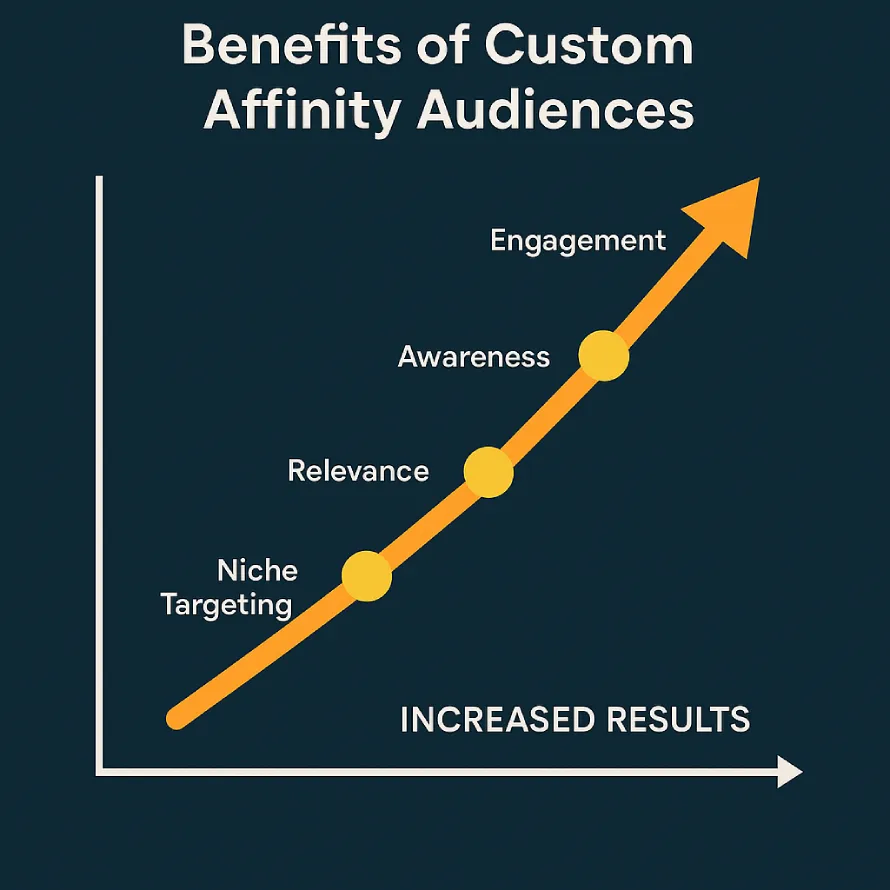Amy has recently created a new brand focused on goldfish training materials—a niche yet growing sport. She knows her audience is small but passionate. To grow her brand, Amy wants to build awareness efficiently within this specific community.
Google Display Ads offer several targeting options, but picking the right one is crucial. In this post, we’ll explain how Amy can reach her niche audience effectively using Google’s Custom Affinity targeting.
Question
Amy has created a new brand for her company’s goldfish training materials. She knows that other companies train goldfish and it is a popular sport, but realizes that it is a niche market. She wants to use a Google Display Ads campaign to build awareness for her new brand. Which Google Display ad targeting option can help Amy with her goal of creating awareness within her niche market?
- Custom Affinity audiences
- Dynamic remarketing
- Affinity audiences
- Standard remarketing
Here is the correct Answer:
✅ Custom Affinity Audiences

Summary Table: Key Points
| Question | Key Answer |
|---|---|
| Difference: Affinity vs. Custom Affinity | Affinity = broad categories; Custom Affinity = highly specific, tailored segments |
| Find new customers? | Yes, ideal for niche marketing |
| How to create? | Use keywords, URLs, apps in Google Ads |
| Combine with other targeting? | Yes, for improved reach and precision |
| Expensive? | Costs vary; often better ROI due to relevance |
| For video ads? | Yes, works with Display and YouTube |
| Track success? | Monitor CTR, engagement, conversions, cost per conversion |
| Update/refine audience? | Yes, adjust based on performance |
| Alternatives? | In-market and Custom Intent audiences |
| Small niche? | Start very specific, test, and broaden if needed |
Why Custom Affinity Audiences Are Best for Amy’s Niche Brand
1. What Are Custom Affinity Audiences?
Custom Affinity audiences allow advertisers to create highly customized audience groups based on detailed interests, specific URLs, places, or apps. Instead of relying on broad, predefined categories, Amy can define her own unique audience reflecting the niche of goldfish training.
2. How Do Custom Affinity Audiences Work?
Amy can input keywords, website URLs, or apps that her target customers are likely to visit or use—like sites about pet training, aquatic sports, or goldfish care. Google then finds users who match these behaviors and interests, delivering Amy’s ads to a highly relevant audience.
3. Benefits for Niche Brand Awareness
- Precision: Focus on very specific interests or behaviors rather than broad groups.
- Control: Tailor targeting to fit the unique aspects of her niche market.
- Efficiency: Avoid wasting budget on audiences less likely to engage.
Custom Affinity audiences help Amy’s brand stand out in a competitive, niche space by reaching the right people with relevant messaging.
Why the Other Options Are Less Suitable
Dynamic Remarketing
- Purpose: Targets users who have already visited Amy’s website with personalized ads based on past behavior.
- Why it’s not right: Amy wants to build awareness, not just retarget existing visitors. Dynamic remarketing is great for conversion but not for reaching new or broad niche audiences.
Affinity Audiences
- Purpose: Predefined broad interest groups like “Sports Fans” or “Pet Lovers.”
- Why it’s not right: These groups are often too large and general. Amy’s niche of goldfish training requires more focused targeting to avoid wasted impressions and budget.
Standard Remarketing
- Purpose: Targets people who previously visited Amy’s website.
- Why it’s not right: It’s limited to past visitors only and doesn’t help build awareness among new potential customers in the niche.
Real-Life Example: Niche Success with Custom Affinity

A company selling custom skateboard gear faced a similar challenge—they wanted to target dedicated skateboarders rather than generic sports fans. Using Custom Affinity audiences, they specified related websites, apps, and interests:
- Their ads appeared mostly to hardcore skateboard enthusiasts.
- Click-through rates were 50% higher than with broad Affinity audiences.
- Brand engagement and conversions improved significantly.
Amy can emulate this approach by targeting goldfish training enthusiasts specifically, maximizing relevance and budget efficiency.
Google Display Ads Targeting Options for Niche Awareness
| Targeting Option | Best Use Case | Pros | Cons |
|---|---|---|---|
| Custom Affinity Audiences | Narrow, niche interest targeting | Highly specific, efficient | Requires research and setup |
| Dynamic Remarketing | Retargeting past website visitors | Personalized ads, high intent | Limited reach to known visitors |
| Affinity Audiences | Broad interest categories | Easy to use, large scale | Too general for niche markets |
| Standard Remarketing | Retarget website visitors | Cost-effective for conversions | No reach beyond existing visitors |

Helpful Resources
- Google Ads Help: Custom Affinity Audiences
- Think with Google: Custom Audience Targeting
- Google Skillshop: Display Ads Certification
- YouTube Tutorial: Custom Affinity Audience Setup
- WordStream: Custom Affinity vs Affinity Audiences
Conclusion
For Amy’s specialized goldfish training materials brand, Custom Affinity audiences provide the perfect targeting solution. They allow her to:
- Reach a highly relevant niche audience
- Build effective brand awareness
- Avoid wasting ad budget on uninterested users
Using this targeting option makes her Google Display Ads campaign smarter, more efficient, and tailored to the unique interests of her customers.
Now, if you are ready, you can take the Google Skillshop test for the Google Ads Display Exam. Want more real exam questions with easy answers like this? Follow along — I’ll be breaking down more Google Ads Display Measurement Certification Free examples in the next posts!
FAQs
1. What’s the difference between Affinity and Custom Affinity audiences?
Affinity audiences are broad, predefined groups created by Google based on general user interests and browsing habits—like “Sports Fans” or “Pet Lovers.” In contrast, Custom Affinity audiences let you build highly specific, tailored segments by choosing detailed interests, keywords, URLs, or apps that closely align with your niche market. This gives you more control and precision.
2. Can Custom Affinity audiences help me find new customers?
Yes! Custom Affinity audiences are designed to help you reach new users who match the precise profiles you define. This makes them ideal for niche marketing where you want to expand your customer base by targeting highly relevant prospects.
3. How do I create a Custom Affinity audience?
In Google Ads, you create a Custom Affinity audience by entering relevant keywords, URLs, places, or apps that reflect your target customers’ interests. This customized list guides Google to find and show your ads to people who exhibit similar behaviors and preferences.
4. Can I combine Custom Affinity with other targeting options?
Absolutely. You can combine Custom Affinity audiences with other targeting methods like demographics, remarketing lists, or in-market audiences to further refine your reach and improve campaign precision—just be sure the combinations align with your overall campaign goals.
5. Is Custom Affinity targeting expensive?
Costs vary depending on your industry, competition, and audience size. However, because Custom Affinity audiences are highly relevant and focused, they often deliver a better return on investment (ROI) than broader, less targeted approaches.
6. Can Custom Affinity audiences be used for video ads?
Yes! Custom Affinity audiences work not only for Display campaigns but also for YouTube video campaigns, giving you flexibility in choosing ad formats and placements.
7. How do I track if my niche targeting is working?
You can monitor key performance indicators like click-through rate (CTR), engagement metrics, conversion rate, and cost per conversion. These metrics reveal how effectively your audience responds to your ads and whether your targeting is on point.
8. Can I update or refine my Custom Affinity audience?
Yes, Custom Affinity audiences are flexible. You can continually adjust and refine your audience parameters based on campaign performance data to optimize results over time.
9. Are there alternatives to Custom Affinity for niche targeting?
Yes, alternatives include:
In-market audiences: Users actively researching or considering purchasing products/services like yours.
Custom Intent audiences: Targeting users based on their demonstrated intent to buy, using specific keywords and URLs.
Both can complement your niche targeting strategy.
10. What if my niche audience is very small?
For very small niche audiences, start with highly specific Custom Affinity settings and test your campaign’s performance. If your reach is too limited, gradually broaden your targeting criteria to ensure enough impressions and engagement, while managing your budget carefully to avoid wasted spend.
